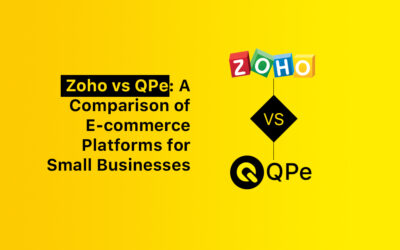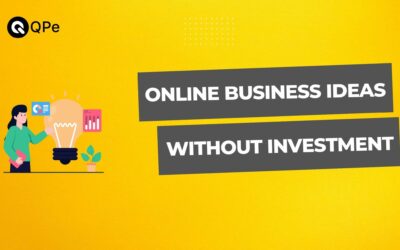It’s a great time to be in India’s e-commerce market. Online shopping has become more common as more people use the internet and smartphones. People love getting stuff delivered right to their doors, regardless of where they live.
There are companies like Amazon, Flipkart, Nykaa, and Meesho that are dominating the marketplace. The cool part is, it’s not just for big players. You can create a full-fledged online marketplace or a small niche store.
If you’ve thought about starting an online business, do it now. As the industry grows and changes, there are more opportunities to shine.
With tools like QPe, you can easily start your store.
It’s super easy to use QPe. Your store can be set up, orders can be handled, and deliveries can be handled all in one place. No matter where you are in your growth cycle, it’s built for you.
So, what are you waiting for?
Let’s learn more about it in the blog.
How to Choose the Right Ecommerce Model
Picking the right ecommerce model? It’s a big deal. The choice impacts everything, your customers, operations, costs, and how far you can scale.
What’s Your E-commerce Model?
1. B2B (Business-to-Business)
This one’s about selling to other businesses. Think bulk goods, SaaS platforms, or materials for manufacturers. B2B deals mean bigger orders and long-term contracts. Sounds great, right? But it’s not all easy. You’ll need to build trust, keep supplies consistent, and deal with longer sales cycles.
Starting out? Stick to a small niche. Find industries that need what you sell. Use LinkedIn to connect with potential clients. Grow slowly as your name gets known.
2. B2C (Business-to-Consumer)
Selling directly to consumers? That’s B2C. It’s the most popular model, but it’s super competitive. To make it work, find a growing niche without much competition. Eco-friendly products or handmade goods are great examples.
Your secret weapons? Strong branding, great customer service, and smart marketing. Use Instagram and Facebook to spread the word. And don’t forget the basics: fast shipping, clear return policies, and responsive support. These details turn one-time buyers into loyal fans.
3. C2C (Consumer-to-Consumer)
C2C is all about people selling to people. Think OLX, eBay, or Facebook Marketplace. It’s a solid choice for selling second-hand or unique items. But there’s a catch, profit margins can be low, and fraud risks are higher.
Want to succeed? Pick a trusted platform with lots of users. Build trust with buyers by being transparent and racking up positive reviews.
How Will You Operate?
Once you pick a model, you need to decide how you’ll run things. Here are three common ways:
1. Dropshipping
Dropshipping is perfect if you’re new and don’t want to deal with inventory. You sell, your supplier ships. Easy, right? The downside? Low profit margins and competition everywhere.
Want to stand out? Choose a niche with fewer players. Work with reliable suppliers, and invest in marketing to drive traffic.
2. Marketplaces
Platforms like Amazon and Flipkart give you a ready-made audience. They handle logistics and add credibility, which makes life easier. But here’s the catch, competition is brutal, fees can eat profits, and you don’t control the customer experience.
To do well, pick products with high demand but lower competition. Optimize your listings with great photos and descriptions. Use ads on the platform to boost visibility.
3. Self-Owned Website
Want full control? Build your own website. You manage branding, customer relationships, and growth. But it’s not cheap. You’ll spend more upfront on website design, marketing, and logistics.
Start smart with e-commerce tools like QPe to set up quickly. Focus on SEO and content marketing to draw people in. Partner with reliable delivery and payment providers for smooth operations.
So, Which One’s for You?
It depends on your budget, skills, and goals. Beginners with tight funds? Try dropshipping or marketplaces. Once you’ve learned the ropes, move to a self-owned site for better control and profits.
Take your time. Think about what you’re good at and what the market needs. The right model can set you up for long-term success.
How To Register An Online Business In India
Online businesses in India are easier than ever with the right guidance. It is important to know the steps if you want to launch your website.
1. Pick Your Business Type
Choose the structure that suits your business goals, like a sole proprietorship or private limited company.
2. Lock in Your Business Name
Decide a name that stands out and register it to make it official.
3. Get Your Tax ID (PAN)
Apply for a Permanent Account Number for your business.
4. Open a Business Bank Account
Set up a current account for smooth financial transactions.
5. Register for GST
Get your Goods and Services Tax number to comply with tax laws.
6. Create Your Online Store
Build a professional website or list your products on popular platforms.
7. Add a Payment Gateway
Set up secure online payments for customer convenience.
8. Protect Your Brand
Register a trademark for your name and logo if needed.
9. Meet All Legal Rules
Ensure you have all licenses and registrations like professional tax or FSSAI.
10. Start Selling Online
Launch your business and start reaching customers across India.
You are now ready to start your online business. You’ll soon be connecting with customers and growing your brand throughout India.
How To Start An E-Commerce Business Without Money
It is possible to start an e-commerce business without money. Get creative with free tools, simple strategies, and free ideas.
How to do it:
-
Leverage Free Tools And Resources
- Build your website on QPe (free trial).
- Accept payments with free tools like PayPal or Razorpay.
- Design your logo and banners with Canva.
- Track inventory with Google Sheets.
-
Explore Dropshipping And Print-On-Demand Options
Dropshipping: List products from suppliers like Oberlo. They ship directly to your customers. You don’t need to buy stock.
Print-on-Demand: Sell custom products like t-shirts through Printful or Printify. You pay only after you make a sale.
-
Use Social Media For Marketing And Sales
- Post product pictures and videos on social media.
- Use hashtags to reach more people.
- Join Facebook groups or Reddit to share tips and promote your products.
- Work with small influencers for free product promotion.
- Sell directly with Instagram Shopping.
Start small, grow with time, and reinvest your earnings. You can succeed without spending a lot upfront.
Steps To Start an E-Commerce Business In India
You don’t need a lot of experience to start an e-commerce business in India. Let’s break it down step-by-step, so it’s clear and easy to follow.
Identify Your Niche And Target Audience
Find what sells: Use tools like Google Trends or check Amazon’s Best Sellers. It’s a great way to spot trends.
Solve problems: Look at what your audience needs. What annoys them? Can you fix it?
Spy on competitors: See what others are doing, then figure out how you can do it better or differently.
Develop A Business Plan
Set goals: Decide what you want in the short and long run.
Pick a model: Are you selling directly to customers (B2C), other businesses (B2B), or both?
Plan money stuff: Estimate costs, expected income, and where you’ll get the funds.
Think marketing: Decide how you’ll get the word out. Social media? Ads? SEO?
Register Your Business
- Choose your business type, like sole proprietor or private company.
- Register for GST to handle taxes.
- Protect your name with a trademark.
Get Products Ready
- Work with trusted suppliers or make products yourself.
- Decide if you’ll stock items or use drop shipping.
Set Up Payments and Shipping
- Use Razorpay, Paytm, or similar for payments.
- Partner with delivery services like Delhivery or Bluedart.
Build Your Website
- Make it simple, fast, and mobile-friendly.
- Add good pictures and clear descriptions for products.
- Use secure payment methods to build trust.
Attract with Stunning Photos
Use clear, high-quality images to showcase your products. Add lifestyle shots to show how your products fit into daily life.
Streamline Checkout
Make checkout easy with quick payment options. Reduce cart abandonment by offering secure and simple payment methods.
Ensure a Smooth Experience
Optimize your site for mobile and desktop users. Make sure it loads fast and is easy to navigate for all customers.
A successful online store starts with these essentials.
Market Your Store
- Post regularly on Instagram and Facebook.
- Optimize your site for search engines (SEO).
- Use blogs or videos to engage customers.
- Run ads if you have the budget.
Test Before Launch
- Share your site with a small group for feedback.
- Fix issues before the big launch.
- Announce your launch with a marketing push.
Keep Improving
- Track your progress with tools like Google Analytics.
- Listen to feedback from customers.
- Update your strategy as trends change.
This is all you need to know. Step by step, and you’ll succeed.
How to List and Optimize Your Products
Want to make your product listings work harder for you? Let’s break it down. Every detail matters, titles, photos, descriptions, everything plays a part in turning browsers into buyers. Here’s how to nail it.
Use Clear Titles
Keep titles simple but loaded with useful info. Think about what someone would search for. Instead of just “Red Shoes,” go for something like “Women’s Comfortable Red Running Shoes.” See the difference? It’s specific and helpful.
Write Descriptions That Sell
Your product description isn’t just filler. It’s your chance to tell people why they need this product. Keep it short and snappy. List key features and benefits in bullet points so it’s easy to skim. Add keywords, but don’t overdo it.
Make Filtering Easy
Don’t make people dig for what they want. Add filters for price, size, color, or whatever makes sense for your products. Sorting options like “Bestsellers” or “Lowest Price” can make shopping faster and easier.
Use Strong CTAs
Your calls to action should be clear and impossible to miss. “Add to Cart,” “Buy Now,” or “Get Yours Today” works. Keep them bold and obvious so there’s no confusion about what to do next.
Be Transparent
Don’t hide prices or stock info. Show everything upfront—pricing, reviews, availability. Got free shipping or a sale? Shout it out! People trust listings that are honest and clear.
Focus on SEO
Keywords aren’t just for search engines—they help real people find your stuff. Use them in titles, descriptions, and even image names. SEO tools like Yoast can help you tweak things to boost visibility.
Recommend More Products
Ever seen a “You Might Also Like” section? Add one! Show related products or bundles like “Frequently Bought Together.” It’s an easy way to boost the shopping cart total.
Keep Listings Fresh
Stale listings get ignored. Update descriptions, swap out photos, or adjust prices now and then. Try A/B testing to see what works best. Little tweaks can lead to big gains.
Track What’s Working
Keep an eye on the numbers. Look at traffic, bounce rates, and sales conversions. Tools like Google Analytics can show you what’s killing it and what needs work.
Great product listings don’t just happen. They take effort, testing, and updates to stay on top. Focus on what customers need, and you’ll see the results.
Conclusion:
The process of starting an online business doesn’t have to be overwhelming. We’ve covered everything you need to know about setting up your store, registering your business, and even starting without any money.
Aside from creating great product listings, we also talked about building your brand and using smart tools.
The best part? QPe makes it all simple. With no coding needed, customizable templates, and built-in tools, you can set up and grow your store quickly. Whether you’re selling products, drop shipping, or offering digital goods, QPe helps you every step of the way.
Ready to get started?
Try QPe for free today and turn your e-commerce ideas into a real business.
Frequently Asked Questions (FAQs):
-
How Can Small Businesses Use E-Commerce To Compete With Big Brands?
By focusing on personalized service, niche products, and unique branding that big brands often can’t match. Use social media and SEO to target specific audiences and build a loyal community.
-
What Is The Best Way To Attract Customers To A New E-Commerce Platform?
Offer irresistible deals like discounts or free shipping and promote them through social media and email. Highlight your unique value and create a seamless shopping experience.



